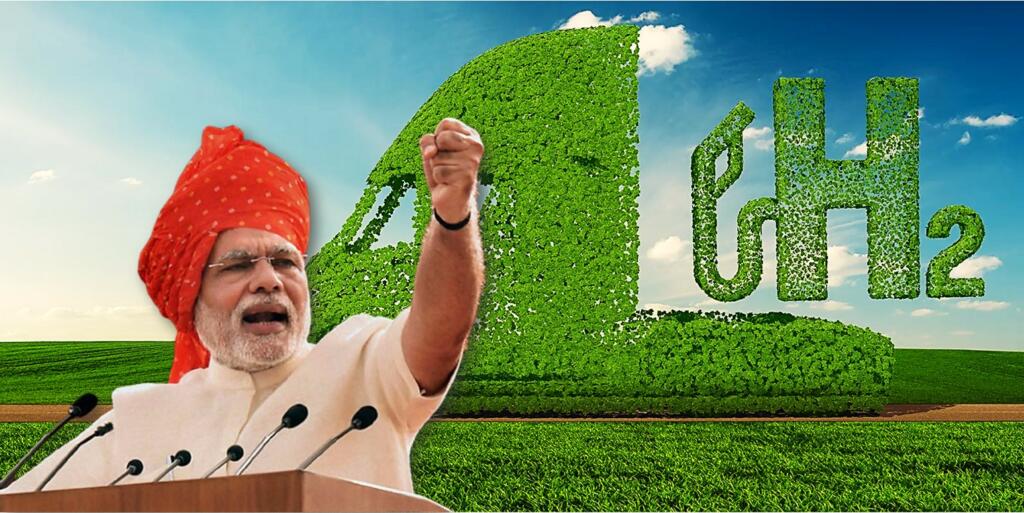Green Hydrogen incentive programme: The Paris Climate Accords was a path breaking moment when 196 parties negotiated a common framework to fight climate change. The international treaty, since its adoption in 2015, has been gotten cold response from major emitters of the world. On the other hand, India is the only G20 nation that has met its climate goals. Unlike other countries, rather than falling short on NDC (Nationally Determined Contributions) targets, India has enhanced its climate targets to keep our planet, Earth, habitable for future generations.
With constant nudging from the Modi government, the private sector has been taking slew of measures to make India self-reliant in clean energy including massive investment in Green Hydrogen. Taking a step further, it seems that the Modi government is ready for capital influx in clean energy production particularly through Green Hydrogen.
Modi government will incentivise production of Green Hydrogen
The Production Linked Incentive (PLI) scheme was a game-changer for the manufacturing sector. It has kick started a new revolution through which the nation is leap frogging new heights in key parameters, be it highest FDI inflow or market giants like Apple and Foxconn expanding their presence in India.
Now, the government wants to replicate this success of its incentivisation policy to fight climate change and give a major boost to clean energy in the country.
Also Read: Brace yourselves for the world’s largest green hydrogen ecosystem, brought to you by Adani
As per media reports, the Modi government is planning a 180-billion-rupee ($2.2 billion) incentive programme for the Green Hydrogen industry. The programme is said to have two main aims in sight.
First, it aims to reduce emissions and reduce the production cost of green hydrogen by a fifth over the next five years. With its incentive programme, the government expects that the industry will attract an investment of around Rs 8 trillion in Green Hydrogen.
Currently, Green Hydrogen costs around Rs 300 to Rs 400 per kg in India. As per reports, the government may give out an incentive of around Rs 50 per kg Green Hydrogen for next three years through this programme.
India: The Emerging powerhouse of future clean energy
The second aim of the possible incentivisation programme will be to make India a major export player in the field of clean energy. As per industry officials, India aims to sell 70% of the production of Green Hydrogen and its derivatives to countries like South Korea, Japan and the European Union.
Also Read: India imported Oil and Gas from OPEC, soon we will be exporting Green Hydrogen to them
As of now, global demand for Green Hydrogen is around 75 million tonnes, which may skyrocket to 100 million tonnes by 2030.
In February, the Modi government announced its plan to make 5 million tonnes of Green Hydrogen annually by 2030. This figure could be doubled as per many domain experts.
Additionally, the Modi government also plans for the nation to achieve electrolyser manufacturing capacity of 15 gigawatts gradually by 2030. This is an ambitious target as 15 gigawatts is almost 10 times the current global capacity that India wants to achieve on its own in around 8 years.
Also Read: Adani thrashes the West, is single-handedly set to make India the superpower in Green Energy
As per reports, the Green Hydrogen proposal is likely to be called “Strategic Intervention for Green Hydrogen Transition” (SIGHT). It may have two different components. One for electrolyser manufacturing that may get around Rs 45 billion for the period of five years. The other component may be for Green Hydrogen and Green Ammonia production that may attract around Rs 135 billion for three years.
As per media reports, these incentives could be made in budgetary announcements on February 1.
Green Hydrogen, Green Ammonia and recent developments
The Hydrogen that is produced by the way of electrolysis of water using renewable energy is termed as Green Hydrogen. Green ammonia is made by combining nitrogen with hydrogen using renewable energy sources. After that, it can be used by the fertiliser industry or as a fuel or convenient means of transporting hydrogen.
Earlier, the United States and the European Union had approved incentives worth billions of dollars for Green Hydrogen projects.
In India, companies like Reliance Industries, Indian Oil, NTPC, Adani Enterprises, JSW Energy and Acme Solar have major plans for Green Hydrogen. Earlier this year, Adani in collaboration with France’s TotalEnergies jointly created the “world’s largest green hydrogen ecosystem.”
Also Read: EV-Lithium – Can we skip to the good part?
The efficiency, range, storage and availability of Hydrogen-based cells are more than the Lithium-based batteries. Plus, the self-life of a Lithium-based battery is less than that of Hydrogen fuel cells. Further, the finiteness of lithium is another constraint.
On account of this, the Union Road and Transport Minister, Nitin Gadkari has been a vocal supporter of Green Hydrogen fuelled vehicles. He even given precedence to it over Electric Vehicles. An incentive programme on this route will be a game-changer that will solve the growing need of energy demand of an emerging global powerhouse, that is, India. With private as well as government infusing capital generously in the clean energy sector particularly Green Hydrogen, India is well placed in its fight against climate change.
Support TFI:
Support us to strengthen the ‘Right’ ideology of cultural nationalism by purchasing the best quality garments from TFI-STORE.COM
